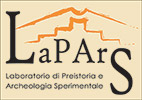Archaeometry
Archaeometry, for years an indispensable research tool in the field of archaeology, has a strategic role in the scientific research undertaken by LaPArs, has provided important results on chronology and the study of craft production.
The C14 datings obtained from the samples gathered in the Badas sector of the Su Coddu/Canelles settlement, have provided clear information regarding the final stages of the Neolithic, and therefore to the period of transition between the Ozieri and the Sub-Ozieri. The results also demonstrated the gradual nature of this transition, as variously confirmed by the data on craft production, by settlement strategies, and by the paleo-economical data. A further result was the confirmation of the seriation created by the typological analysis (Melis 2000), which established the antecedence of the Sub-Ozieri to the Filigosa. The re-examination of the available chronological data for the Eneolithic has also made possible a re-reading of the chronological sequence of the site at Monte d'Accoddi.
Concerning craft production, the application of archaeometric analysis proves fundamental in examining the processes of selection and preparation of the raw materials, and while defining them provides information about their provenance as well as an objective evaluation of their quality. This in turn serves to define the rapport between community and territory in terms of mobility and exploitation of resources, and helps distinguish functional and cultural choices. The results are also expected to make it possible to detect the presence or absence of a consistent relationship between functional forms (for example, in the case of pottery: cooking vessels, storage vases or pots designed to hold liquids, etc.) and the raw materials employed. In an attempt to reconstruct the economy of clay at the settlement of Su Coddu-Canelles (Selargius, Cagliari) samples of plaster, clay bricks/standardised blocks, non-pottery terracotta (such as loom-weights) and a representative quantity of impasto pottery fragments were taken. Observations made during the selection of the samples made it possible to compile an "impasto record sheet" for each which, through providing an objective description, serves as reference for future research; once again, the quantity of material available to study proved to be of fundamental importance, together with the experience of the researcher handling the objects.
In the field of metallurgy some archaeometric analyses were undertaken with the intention of verifying the presence of in locosmelting; the slag deposits found at the Badas area of excavation, analysed by Paolo Mulé for gas chromatography-mass spectrometry and by Paola Mameli using x-ray powder diffraction (XRPD) and a scanning electron microscope (SEM), accompanied by EDS microanalysis, do not appear to be the result of smelting metals. l campo della metallurgia alcune analisi archeometriche sono state effettuate allo scopo di verificare la presenza di attività fusoria in loco: il materiale scoriaceo rinvenuto nel lotto Badas, analizzato da Paolo Mulé al gas massa e da Paola Mameli in diffrattometria di raggi X su polveri (XRPD) e in microscopia elettronica a scansione (SEM), corredata da microanalisi EDS, non sembra derivare da fusione di metalli.
